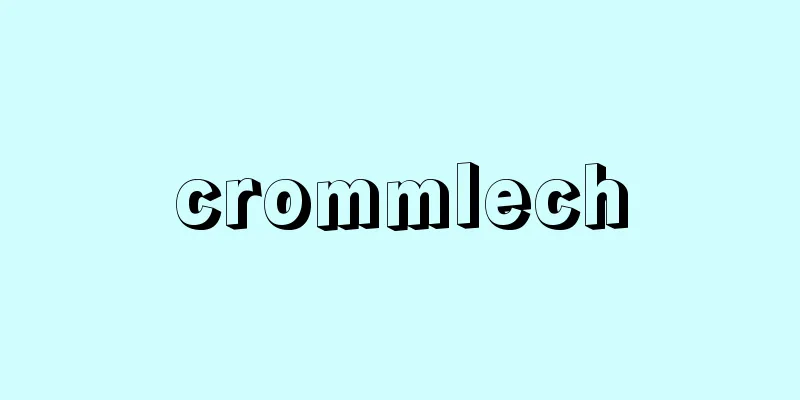Irihama salt fields - Irihama salt fields

|
...According to old maps from the early 17th century and Keicho land survey records, the existence of about 100 hectares of traditional salt fields can be confirmed along the coast of Ako Bay. Around 1625 (Kan'ei 2), "salt fields" appeared in the eastern part of Himeji Domain, and their construction began in Ako in 1645 (Shoho 2). Salt fields in Ako were produced and managed on an average of 1.5 hectares, and together with one salt pan, they were called a "house," and about 10 women and children were employed as advance wage laborers. ... From Shiota … From [Salt]…Salt is also called table salt, but chemically it is called sodium chloride (NaCl), and is a colorless, transparent, regular hexahedral crystal in which sodium ions and chlorine ions are regularly arranged, and it also has cleavage. Depending on the manufacturing method, the crystals can have an irregular shape and a variety of hues. Its specific gravity is about 2.2, its Mohs hardness is 2-2.5, its melting point is around 800°C, its boiling point is 1440°C, and the freezing point of saturated salt water is -21°C. Its solubility in water varies little with temperature, being 26.4% at 20°C and 26.9% at 100°C. … From [Harima Province]...Between 1600 and 1604, salt fields were developed in Takasago and Arai villages in Kako County, followed by salt fields built in Sone, Oshio, and Matogata in Innami County, and then Kiba village in Shikahigashi County. These were traditional inlet-type salt fields, but inlet-type salt fields were established around Arai Village around the time of the Kan'ei era. This technology was transferred by the local salt farmers to Ako when the Asano clan took over the area in 1645, and was perfected at the Higashihama salt fields in the same area. ... *Some of the terminology used to refer to "Irihama Salt Fields" is listed below. Source | Heibonsha World Encyclopedia 2nd Edition | Information |
|
…17世紀初頭の古地図と慶長検地帳によると,赤穂湾岸一帯に約100haの古式入浜の存在が確認できる。1625年(寛永2)ころ姫路藩東部に〈入浜塩田〉が出現し,45年(正保2)から赤穂でも造成が始まる。入浜塩田とは平均1.5haを生産・経営の単位とし,これに塩釜1基を合わせて一軒前といい,女,子ども合わせて約10人を前貸制賃労働として雇用した。… 【塩田】より… 【塩】より…塩は食塩とも呼ばれるが,化学的には塩化ナトリウムNaClと呼ばれ,ナトリウムイオンと塩素イオンとが規則正しく配列した無色透明の正六面体の結晶で,へき開性もある。製法により結晶の外形も不定形になり,色相も種々の色を呈する。比重は2.2程度,モース硬度は2~2.5,融点は800℃付近,沸点は1440℃,飽和食塩水の氷点は-21℃である。水に対する溶解度は,温度によりほとんど変わらず,20℃で26.4%,100℃で26.9%である。… 【播磨国】より…1600‐04年の間に加古郡高砂・荒井両村に塩田が開発され,つづいて印南郡曾根,大塩,的形から飾東郡木場村にかけて塩田が造られた。古式入浜塩田であったが,やがて寛永ごろ荒井村あたりで入浜塩田が創始された。この技術は,この地の浜人によって浅野氏入封(1645)当初の赤穂に移され,同地の東浜塩田において完成をみた。… ※「入浜塩田」について言及している用語解説の一部を掲載しています。 出典|株式会社平凡社世界大百科事典 第2版について | 情報 |
<<: Right of access to the beach
Recommend
Cunliffe Committee
The Committee on Post-War Currency and Foreign Exc...
The Tale of Matsuura Palace
A Giko Monogatari from the very end of the Heian ...
Tiraspol' (English spelling)
A city in eastern Moldova. It is located about 70 ...
Calorie - Calorie (English spelling)
In physics, the joule is used as the unit of ener...
Delicious - Delicious
An insect belonging to the family Tettigoniidae i...
Farmers' Alliance
A general term for farmer groups that gained influ...
Early - Wase
A group of crop varieties that mature early and ca...
Rhinolophus ferrumequinum (English spelling) Rhinolophusferrumequinum
…[Yoshiyuki Mizuko]. . . *Some of the terminology...
Dimensionless number - MUJIGENSU
Any quantity observed physically has dimensions. H...
Abner Doubleday
…This committee was formed at the request of Albe...
Built-in - Uchikura
〘Noun〙 (also "Uchigura") 1. One of the t...
Earl of Elgin
...Anti-British movements were growing around Gua...
Lapel
… [Yamashita Etsuko] [Clothes collar] In English,...
Keimatsu Imai - Keimatsu Imai
A Yamada school koto musician. His real name was ...
Civil Service Appointment Order - Bunkanninyorei
An imperial ordinance that stipulated the appoint...

![Aji [town] - Aji](/upload/images/67cad32dac8bd.webp)







